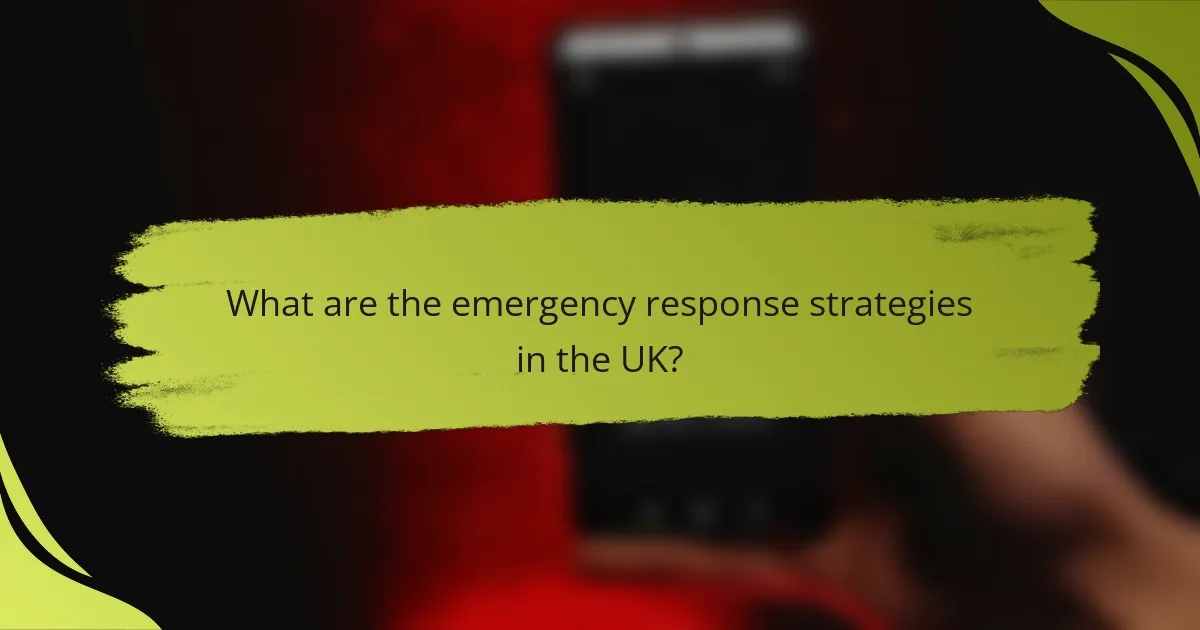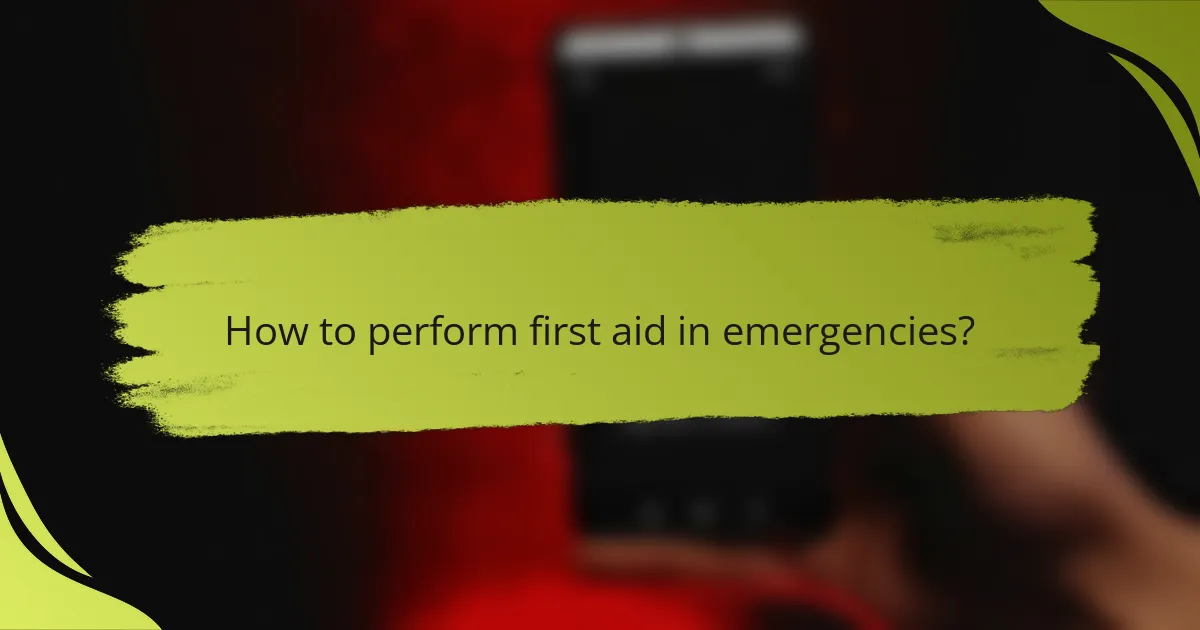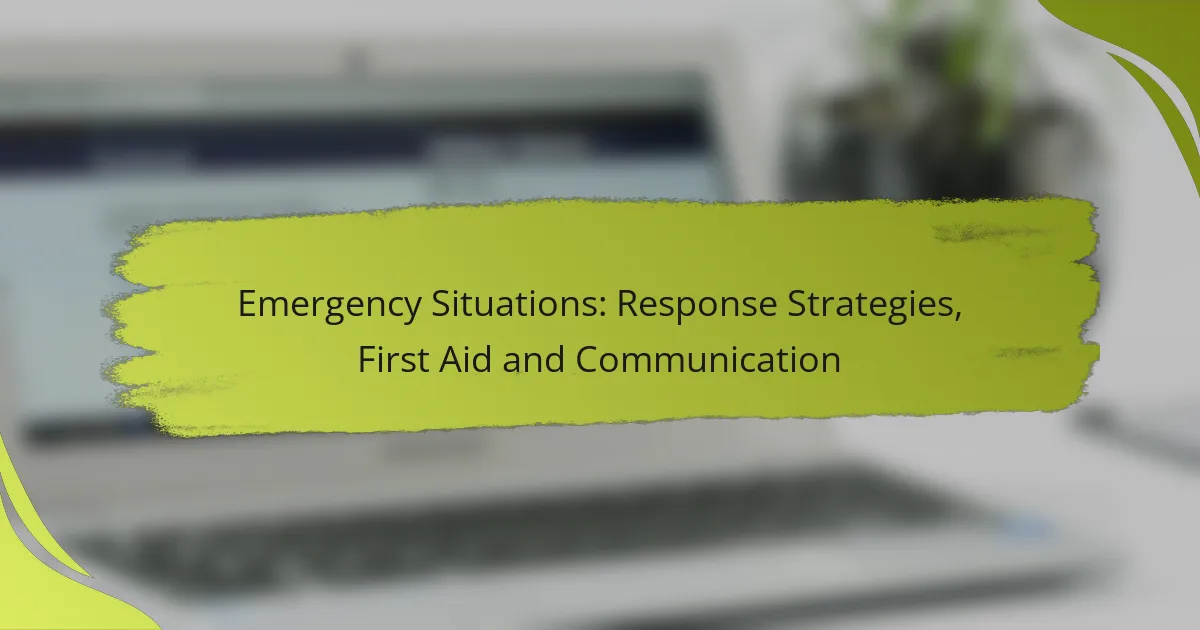In emergency situations, a structured response strategy is essential for effective crisis management, focusing on immediate assessment and coordination with local services. First aid plays a critical role in providing immediate care to those injured or ill, while effective communication ensures safety and facilitates a coordinated response. Understanding these elements is vital for anyone looking to enhance their preparedness for emergencies.

What are the emergency response strategies in the UK?
Emergency response strategies in the UK involve a structured approach to managing crises effectively. These strategies prioritize immediate assessment, safety, casualty management, coordination with services, and utilization of local resources.
Immediate assessment of the situation
The first step in any emergency response is to assess the situation quickly and accurately. This involves identifying hazards, the number of casualties, and the severity of injuries. A rapid evaluation helps determine the necessary actions and resources required.
Use the acronym “SAMPLE” to guide your assessment: Signs and symptoms, Allergies, Medications, Past medical history, Last oral intake, and Events leading up to the incident. This can streamline information gathering during emergencies.
Establishing a safe environment
Creating a safe environment is crucial to prevent further harm to victims and responders. Ensure that the area is secure from ongoing threats, such as fire, traffic, or hazardous materials. If necessary, move casualties to a safer location.
Use barriers or warning signs to keep bystanders away from the scene. This not only protects them but also allows emergency responders to work without distractions or additional risks.
Prioritizing casualties
In emergencies, prioritizing casualties based on the severity of their injuries is essential. Use a triage system to categorize individuals into groups: immediate, delayed, and minor. This helps allocate resources effectively and ensures that those in critical need receive attention first.
For example, a person with severe bleeding or difficulty breathing should be treated before someone with minor injuries. This systematic approach can save lives and optimize the use of available medical personnel.
Coordinating with emergency services
Effective coordination with emergency services is vital for a successful response. As soon as the situation is assessed, contact local emergency services by dialing 999 in the UK. Provide clear information about the incident, including location, number of casualties, and types of injuries.
Establish a communication channel with emergency responders to relay updates and additional needs as the situation evolves. This ensures that help arrives promptly and is prepared for the conditions on the ground.
Utilizing local resources
Leveraging local resources can significantly enhance the response to an emergency. Identify available community resources, such as first aid volunteers, local hospitals, or nearby shelters that can assist in managing the situation.
Consider creating a list of local contacts and resources ahead of time, including medical facilities and emergency numbers. This preparation can streamline the response process and improve outcomes during an actual emergency.

How to perform first aid in emergencies?
First aid in emergencies involves immediate care provided to an injured or ill person until professional medical help arrives. Key actions include assessing the situation, providing basic life support, and managing wounds effectively.
Basic life support techniques
Basic life support (BLS) techniques are crucial for sustaining life in emergencies. This includes performing cardiopulmonary resuscitation (CPR) and ensuring the airway is clear. For adults, CPR typically involves 30 chest compressions followed by 2 rescue breaths.
It is essential to call emergency services before starting BLS. If you are untrained, focus on hands-only CPR, which consists of continuous chest compressions at a rate of 100 to 120 per minute.
Wound care and management
Proper wound care is vital to prevent infection and promote healing. Start by washing your hands and wearing gloves if available. Clean the wound gently with soap and water, then apply an antiseptic.
Cover the wound with a sterile bandage or dressing. Change the dressing regularly and monitor for signs of infection, such as increased redness, swelling, or discharge.
Recognizing and treating shock
Shock is a life-threatening condition that occurs when the body is not getting enough blood flow. Symptoms include rapid heartbeat, shallow breathing, confusion, and pale skin. Recognizing these signs early is critical for effective treatment.
To treat shock, lay the person down and elevate their legs if there are no injuries that prevent this. Keep them warm and calm while waiting for emergency services. Do not give them food or drink.
Using an Automated External Defibrillator (AED)
An Automated External Defibrillator (AED) can be lifesaving in cases of cardiac arrest. It analyzes the heart’s rhythm and delivers a shock if necessary. Most AEDs provide audio and visual instructions, making them user-friendly.
To use an AED, turn it on and follow the prompts. Attach the pads to the bare chest of the person in need, ensuring they do not touch the victim while the AED analyzes the heart rhythm. If a shock is advised, ensure everyone is clear before delivering it.

What communication methods are effective during emergencies?
Effective communication during emergencies is crucial for ensuring safety and coordinating responses. Key methods include clear verbal communication, using emergency services numbers, leveraging social media for updates, and establishing a communication plan.
Clear verbal communication
Clear verbal communication is essential in emergencies to convey critical information quickly and accurately. Use simple language and avoid jargon to ensure everyone understands the message. Speak loudly and calmly to maintain composure and facilitate understanding.
When giving instructions, be direct and specific. For example, instead of saying “over there,” specify “to the left of the main entrance.” This clarity can significantly reduce confusion and improve response times.
Using emergency services numbers
Knowing the correct emergency services numbers is vital for prompt assistance. In many countries, dialing a universal emergency number like 112 or 911 connects you to police, fire, and medical services. Familiarize yourself with these numbers and any local variations.
When calling emergency services, provide essential information such as your location, the nature of the emergency, and any immediate dangers. Stay on the line until instructed to hang up, as operators may need additional details.
Utilizing social media for updates
Social media can be a powerful tool for disseminating information during emergencies. Platforms like Twitter and Facebook allow for real-time updates and can reach a wide audience quickly. Use official accounts or verified pages to share accurate information and avoid spreading rumors.
Consider creating a dedicated hashtag for your community to streamline communication. This can help people find relevant updates and share their own experiences or needs during an emergency.
Establishing a communication plan
Establishing a communication plan before an emergency occurs can save time and reduce panic. This plan should outline how family members or team members will communicate during a crisis, including designated meeting points and preferred communication methods.
Include backup options in case primary methods fail. For instance, if mobile networks are down, consider using text messages or social media as alternatives. Regularly review and practice the plan to ensure everyone is familiar with it.

What are the prerequisites for effective emergency response?
Effective emergency response relies on proper training, knowledge of local protocols, and community preparedness. These elements ensure that individuals can act swiftly and appropriately during crises, minimizing harm and enhancing recovery efforts.
Training and certification programs
Participating in training and certification programs is crucial for anyone involved in emergency response. These programs often cover first aid, CPR, and advanced life support techniques, equipping responders with the skills needed to handle various situations.
Look for programs accredited by recognized organizations, such as the American Red Cross or local health authorities. Regular refreshers every couple of years help maintain skills and knowledge, ensuring readiness when emergencies arise.
Understanding local emergency protocols
Familiarity with local emergency protocols is essential for effective response. Each region may have specific procedures for handling disasters, including evacuation routes, emergency contacts, and resource availability.
Stay informed about your area’s emergency management plans by attending community meetings or reviewing local government websites. Knowing how to access emergency services and communicate with them can significantly improve response times and outcomes.
Community preparedness initiatives
Community preparedness initiatives foster collaboration and readiness among residents. These programs often include drills, workshops, and resource sharing, which help build a resilient community capable of responding to emergencies.
Engage with local organizations that promote preparedness, such as neighborhood watch groups or volunteer fire departments. Participating in these initiatives not only enhances individual readiness but also strengthens community ties, making collective response more effective during crises.

How to choose the right first aid kit for emergencies?
Selecting the right first aid kit for emergencies involves assessing your specific needs, the environment, and the types of incidents you may encounter. A well-equipped kit should contain essential supplies tailored to address common injuries and health issues you might face.
Essential items for a first aid kit
A comprehensive first aid kit should include items such as adhesive bandages, sterile gauze pads, antiseptic wipes, adhesive tape, scissors, tweezers, and a CPR face shield. Additionally, including a digital thermometer, pain relievers, and a first aid manual can enhance your preparedness.
Consider including personal medications, allergy treatments, and any specific items relevant to your family or group’s health needs. Regularly check and restock your kit to ensure all items are within their expiration dates and in good condition.
Considerations for specific environments
Your first aid kit should reflect the environment where it will be used. For outdoor activities, include items like insect repellent, sunscreen, and a snake bite kit. In urban settings, consider adding a tourniquet and emergency blanket for trauma situations.
If you have children, include child-friendly items such as pediatric medications and smaller bandages. For workplaces, ensure compliance with health and safety regulations by including items specific to your industry.
Regulatory standards in the UK
In the UK, first aid kits should comply with the Health and Safety (First-Aid) Regulations 1981, which outline the minimum requirements for workplace first aid provisions. Kits should be easily accessible and regularly maintained to ensure they meet these standards.
Employers must assess their workplace risks and provide adequate supplies based on the number of employees and the nature of the work. The British Standard BS 8599-1 provides guidance on the contents of first aid kits for various workplace environments.
